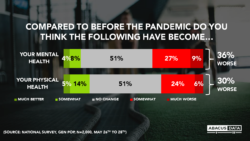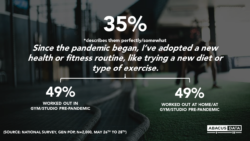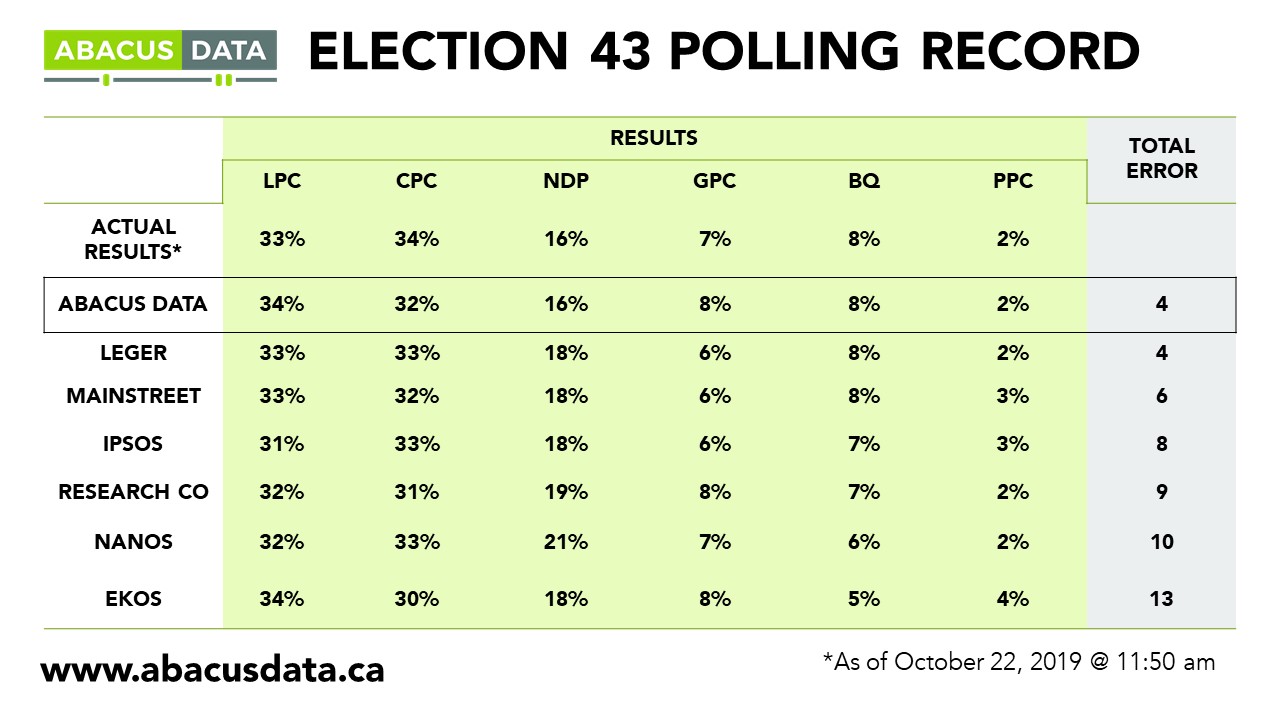Pandemic Fitness: From gym closures to Zoom workouts
June 3, 2021
Like many of our pre-pandemic routines, our health and fitness habits have been altered during the last 14 months. With gyms and fitness classes open in some jurisdictions and closed in others, many Canadians have been left to improvise our workouts at least some point during the pandemic.
We were curious just how many of us have attempted an online workout in our living rooms, stocked up on too many pairs of leggings, or purchased a weight set that is now just sitting in the corner of our bedroom.
Did Canadians continue to workout during the pandemic? Did anyone pick-up a new fitness routine? And what do think our fitness habits will look like post-pandemic? Will our newly purchased dumbbells collect dust as we head back to the gym, or will we continue to ride our Pelotons?
Before we dig into our habits, how do Canadians feel about the pandemic’s impact on their health?
As of right now, the majority of us say our mental and physical health is no different than before the pandemic. This wasn’t always the case (earlier this year we were much more pessimistic). However, among those who have seen a change, it’s most likely for the worse. 36% say their mental health is worse compared to pre-pandemic. 30% say the same about their physical health.

All in, over half (54%) of Canadians participated in some kind of ‘pandemic-modified’ fitness over the past year or so. This includes things like streaming an online workout, doing an at-home self-guided workout or participating in an outdoor workout class.
Streaming classes have been popular during these past few months. One in five (21%) have streamed a workout class like a spin class or bootcamp. And one in four say they’ve streamed some free content, like a yoga class from YouTube.
Most popular is a self-guided at home workout, like lifting weights or going for a run. 46% Canadians say they’ve done this at least once in the last few months.

For Canadians who were already exercising pre-pandemic (working out at home, at the gym, or a class/group at least weekly), 76% say they’ve done some kind of ‘pandemic-modified’ fitness. And focusing in on just those who used to work out a gym or studio, even these gym aficionados have been tempted to move their fitness routines into their homes. 66% have tried some kind of ‘pandemic-modified’ workout.
The pandemic has also inspired some to start working out in general. Even Canadians who weren’t much for fitness before the pandemic have been trying out some of these new trends. For those of us who only worked out occasionally, 22% have tried streaming a class, or doing a self-guided at home workout.
For many of us these new types of workouts have become a bit of a routine. 35% of Canadians say they have adopted a new health or fitness routine during the pandemic like a new diet or trying a new type of exercise. This jumps to 49% for Canadians who already had some kind of pre-pandemic habit as well.

To supplement our pandemic fitness habits, many Canadians have made a purchase related to their new exercise routine. 21% of us have purchased at home workout equipment (though how many of us actually used the equipment is unknown…), 8% purchased a membership for virtual classes, only slightly higher for those who used to frequent gyms/studios (12%). And 11% of us purchased more workout clothing (think, leggings that you wear for your at home yoga, or Zoom calls, no judgement..).

All in all, about a quarter (23%) of us say our fitness spending increased during the pandemic. The same number (23%) say they’ve been spending less. And for half, our fitness budget has remained unchanged.
But what about post-pandemic? Will we all still be using our at home weight sets, or will we be signing up for a new gym membership as soon as we can?
As of right now, post pandemic habits remain to be seen. What is for sure, is that the disruption caused by the pandemic is likely here to stay.
To begin, 40% of us say we will be going back to our old fitness habits. For these Canadians, the routines they adopted during the pandemic are just temporary. This jumps to 55% of those who worked out in a studio/gym pre-pandemic.
But there is also room to keep some of the habits we developed during the pandemic. 57% plan on keeping at least some of their at-home exercise habits once the pandemic is over. This includes both those who are eager to get back to their old habits (like those who want to get back to the gym, but keep their new at-home yoga routine), or even those who, before the pandemic, didn’t have any real fitness routine.
And there’s also room to develop a new routine too. During the pandemic, with time to spare and tons of free online classes, many of us tried something new. Perhaps logging into a local yoga studio’s online classes or streaming a free live workout from your local gym. It seems like these offerings may spur some new post-pandemic customers. 24% of Canadians plan on signing up for a new fitness class/gym membership they didn’t have during the pandemic.

THE UPSHOT
According to Oksana Kishchuk: A lot has changed in the fitness industry throughout the pandemic. When our pre-pandemic habits were paused, many Canadians improvised at home, trying out a virtual class or attempting some version of a bodyweight workout we found on YouTube.
For the Canadians that purchased a kettlebell or two of Amazon this year and may or may not have used them, you likely aren’t alone. For companies that make/sell at home workout equipment- it’s likely the pandemic caused a surge in sales- but it also seems like it has created a new group of Canadians who have bought into the idea of at home workouts and will be keeping it up. And for gyms and studios, while your services may have been closed, your members are eagerly awaiting their return- and it’s likely some new members will tag along too!.
And don’t miss any of our research and analysis, plus get our weekly Worth A Look newsletter. Sign up today.
METHODOLOGY
The survey was conducted with 1,900 Canadian adults from April 16 to 21, 2021. A random sample of panelists were invited to complete the survey from a set of partner panels based on the Lucid exchange platform. These partners are typically double opt-in survey panels, blended to manage out potential skews in the data from a single source.
The margin of error for a comparable probability-based random sample of the same size is +/- 2.23%, 19 times out of 20.
The data were weighted according to census data to ensure that the sample matched Canada’s population according to age, gender, educational attainment, and region. Totals may not add up to 100 due to rounding.
This poll was conducted and paid for by Abacus Data.
ABOUT ABACUS DATA
We are the only research and strategy firm that helps organizations respond to the disruptive risks and opportunities in a world where demographics and technology are changing more quickly than ever.
Find out more about what we are doing to help clients respond to the COVID-19 pandemic.
We are an innovative, fast-growing public opinion and marketing research consultancy. We use the latest technology, sound science, and deep experience to generate top-flight research-based advice to our clients. We offer global research capacity with a strong focus on customer service, attention to detail and exceptional value.
We were one of the most accurate pollsters conducting research during the 2019 Canadian Election.

Contact us with any questions.
Find out more about how we can help your organization by downloading our corporate profile and service offering.



